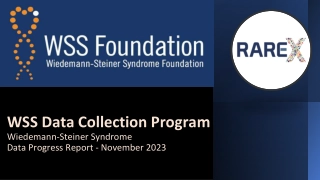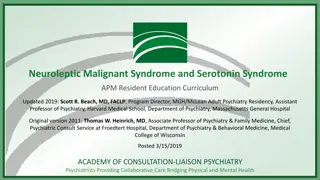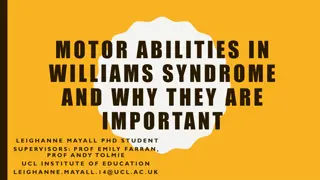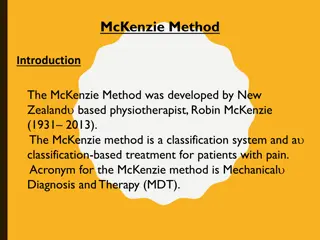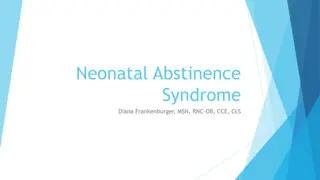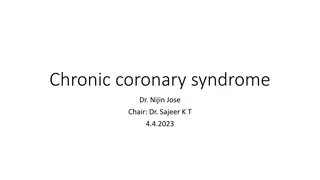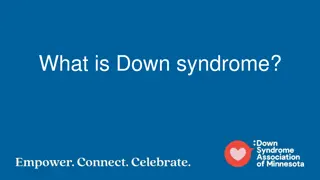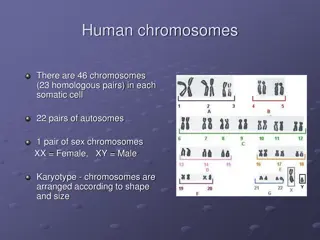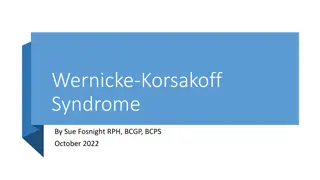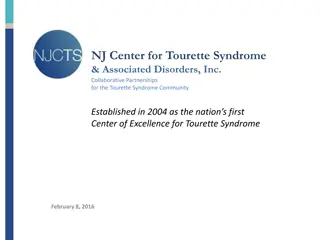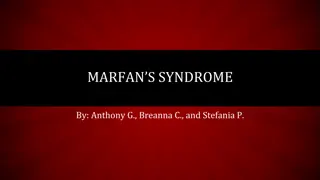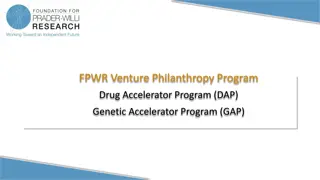Understanding Basic Issues for Students with Prader-Willi Syndrome in School
Key issues affecting the educational progress of students with Prader-Willi Syndrome include behavior, anxiety, motor challenges, verbal deficits, social skills difficulties, processing delays, and untrained staff. Strategies such as structure, positive behavior plans, staff training, effective communication, and addressing individual needs are crucial for creating a conducive learning environment. Remembering that each student is unique and the importance of long-term support in special education is emphasized.
- Prader-Willi syndrome
- Special education
- School environment
- Student challenges
- Educational strategies
Download Presentation

Please find below an Image/Link to download the presentation.
The content on the website is provided AS IS for your information and personal use only. It may not be sold, licensed, or shared on other websites without obtaining consent from the author. Download presentation by click this link. If you encounter any issues during the download, it is possible that the publisher has removed the file from their server.
E N D
Presentation Transcript
MODULE 6: PWS IN THE SCHOOL ENVIRONMENT The Wyatt Special Education Advocacy Training (WSEAT) A Resource of PWSA (USA) www.pwsausa.org
PWS IN THE SCHOOL SETTING: BASIC ISSUES [NOT IN ORDER OF IMPORTANCE] Issues which can generally affect progress at school: behavior, anxiety, fine motor challenges, gross motor challenges, perseveration/rigidity, verbal deficits, social skills challenges, processing delays, untrained staff 1. Structure, consistency, routine 2. Positive, consistent behavioral plan 3. Food-secure environment 4. Staff training, knowledge, interest 5. Communication with student 6. Communication among parents and IEP team 7. Transitions 8. 2
PWS IN THE SCHOOL SETTING: BASIC ISSUES [NOT IN ORDER OF IMPORTANCE] Supervision 9. 10. Substitutes and staff changes 11. Discipline and the School Code of Conduct 12. Behavior issues 13. Transportation 14. General health issues 15. Purpose of school 16. Instructional needs, curriculum adjustments 17. Placement choices 3
PWS IN THE SCHOOL SETTING: BASIC ISSUES Keep in mind: All of the items on the list will overlap. Every student with Prader-Willi Syndrome is different and will have varying levels of difficulty and success in the listed areas. The process of special education is a marathon, not a sprint. Keep both a short-term and a long-term perspective. 4
1. ISSUES WHICH CAN INTERFERE WITH PROGRESS AT SCHOOL Behavior: Frequent behavior situations, when not handled appropriately by staff, will interfere with the child s educational progress. Anxiety: can be generalized, constant anxiety, and/or food-related, and/or related to the actions of untrained staff. Fine motor challenges: Student ultimately is at school to learn, not to produce perfect handwriting, coloring, or art projects. Request an Assistive Technology assessment to make keyboarding an option if handwriting is challenging. Gross motor challenges: Low muscle tone affects the student s abilities in regular play and movement at school, as well as participation in physical education classes. Perseveration/rigidity: Students with PWS can get stuck on a thought, on an activity, on rigid adherence to the rules or directions. 5
1. ISSUES WHICH CAN INTERFERE WITH PROGRESS AT SCHOOL Verbal deficits: If the student is fully or partially non-verbal, this will affect their school experience but it is manageable. frequent and substantive communication with parent from school staff is crucial. Social Skills challenges: Interacting productively and effectively with others, in and outside the classroom, is a complex skill. Processing delays: Students with PWS process all information at a delayed speed. This includes conversations, directions, academic subjects, their classmates actions, etc. Untrained staff: PWS is a complex diagnosis and affects many areas of the school day. Staff who are unaware of PWS- specific school concerns may unintentionally trigger anxiety and non-preferred behaviors in the student. 6
2. STRUCTURE, CONSISTENCY & ROUTINE Students with PWS need to have a solid structure to their school day and week As few changes as possible Planned out well in advance The staff should know the student s schedule thoroughly but should only talk about what is coming within the next hour or day. Mentioning activities to the student too far in advance will increase anxiety about and perseveration on the activity. The student with PWS requires consistency not only with classroom and school activities but also with the staff who work with them. Frequent changes between teachers and aides will escalate the student s anxiety. The student with PWS requires treatment and interaction which is consistent on all levels; thus, all staff working with the student should attend a yearly PWS behavior and training meeting to learn what consistent treatment looks like for this student. Behavior plans must be reviewed yearly and consistently implemented. [3, 5, 6, 7, 10, 12, 17] 7
3. POSITIVE, CONSISTENT BEHAVIOR PLAN If behavior situations are becoming more frequent, it is necessary for you to request in writing that a Functional Behavior Assessment be done for your child. The data collected will indicate what your child s trigger situations are. The IEP team then meets to discuss the data collected. The team then creates a Positive Behavior Intervention Plan [PBIP], so that the student s non-preferred behaviors are addressed appropriately and preferred behaviors are rewarded consistently/effectively. Positive behaviors should be enthusiastically acknowledged and praised. It is not appropriate or effective for the school to repeatedly send your child home or suspend him/her for disability-related non-preferred behaviors. [11, 5, 12, 4] 8
4. FOOD-SECURE ENVIRONMENT A food-secure school setting is required for the student with PWS to be able to access their free-and-appropriate public education. The student cannot control the message of hunger being sent out from their brain. Thus: There should be no food-based curriculum in any of their classrooms. The most effective place to store necessary foods such as lunch bags and snack supplies is outside the classroom, in a (locked) cabinet or covered container. Food in the classroom becomes an extreme distraction and source of anxiety for the student and they cannot concentrate. Trash cans should have lids, and should be locked if possible (with access only to throw away trash). It is common for students with PWS to look through trash cans for food. [7, 8, 9, 10, 11, 12, 13, 14, 18] 9
4. FOOD-SECURE ENVIRONMENT There should be no food in the classroom, including candy dishes/drawers, drink containers for students or staff, or random treats . Teacher should refrain from rewarding the class with food items. Optional rewards can be extra recess time, extra free time, lunch with the teacher, non-food items. Birthday/holiday food treats should be pre-planned and as healthy as possible. Parents should be notified at least one week prior to any unavoidable food situations in the classroom. The IEP team should be aware that the student eats only the food sent from home and/or food choices which are pre-planned with the parent(s). The IEP team should assess the entire school building, including transportation vehicles, for food-security issues. Are there candy dishes sitting out in the main office? Does the school have and enforce a no-food policy on school transportation? Are there vending machines in the school? Has the school arranged for 1:1 supervision for the student during lunch and snack times, on school transportation, and when the student is walking through the school? 10
5. STAFF TRAINING, KNOWLEDGE & INTEREST Yearly training for staff can be written in to the IEP every year as a related service. Staff training is especially important when there is a change in teachers, and when the student transitions to a new school building. Training can be done by the parent or by a PWS professional. Regular training is crucial because: The child s teachers and staff change over time. The child s needs will change as they get older. PWS is very complex, and just having IEP goals in various academic areas is not enough. In order for the student s day and treatment to be as consistent as possible, the entire IEP team needs to be on the same page . [2, 3, 4, 6, 9, 11, 12, 14, 17] 11
6. COMMUNICATION WITH THE STUDENT Students with PWS are always going to be very concrete thinkers with a slow processing speed for all situations and interactions. Abstract concepts in all settings reading, math, human behavior will be challenging. Communication and interactions with the student should be simple, using clear language and using as few words as possible. Directions should be given one step at a time, checking for comprehension and leaving time for processing and response. [5, 11, 12, 17] 12
6. COMMUNICATION WITH THE STUDENT If the student is upset or their behavior is escalating, sshhhh, be quiet. Continuing to talk to them or reason with them is too much auditory input and will prolong and increase the behavior issues. For the student with PWS, behavior IS communication. The student will pick up on and mimic your communication demeanor; if you are positive and encouraging you will help them feel stable, and if you are angry/hostile, their anxiety will increase. If the student is fully or partially non-verbal, the IEP team must discuss and decide on coping options, and brainstorm ways for the student to Communicate their feelings and Choose coping options. 13
7. COMMUNICATION BETWEEN PARENTS & IEP TEAM MEMBERS Parents are equal members on the IEP team. Decisions about their child s programs, services, and supports require the parent s input. Parents should always put requests for adjusted services, additional supports, or assessments in writing to the entire IEP team. At the beginning of each school year, parents should write up a list of the names and email addresses of all IEP team members. When parents have concerns, it is best if those concerns are communicated to the entire team through email. [2-6, 8-18] 14
7. COMMUNICATION BETWEEN PARENTS & IEP TEAM MEMBERS It is not effective to communicate through text messaging. Text messaging does not keep the entire IEP team informed of issues. It also does not formalize concerns or service requests. Texting with a teacher can give the false impression that an issue has been resolved. Communication with the team should always keep the long- term relationship with the school and school district in mind. Be firm and polite in making requests. When in doubt, ask the school staff for data, state law, or school policy to clarify their reasoning. 15
8. TRANSITIONS Individuals with PWS are very concrete thinkers and have a delayed processing speed. They can also be stubborn. Thus: Rushing the student causes stress and frustration, which can lead to behavior issues. Transitioning smoothly between activities and school settings requires that the student be prompted 2-5 minutes ahead that they should finish what they are doing. If the student regularly becomes upset when not able to finish a worksheet or project, set up a place where unfinished work can be stored, and a set time for the student to come back to it. A visual schedule, made easily available to the student, can help with transitions. A timer can also be helpful, as long as the student does not obsess about it and it does not increase anxiety. The student can also find transitions difficult when in very busy classrooms, as they are distracted by watching their classmates. This is where 1:1 aide support is very helpful in helping the student stay focused. [2, 3, 5, 6, 9, 12] 16
9. SUPERVISION Your child may need a different level of supervision than another child with PWS. Always clarify the type (aide, paraprofessional) and level (1:1 dedicated, 1:1 generalized, proximal, visual, arm s length) of supervision. Always document the type and level of supervision in the IEP ( related services and/or accommodations areas). If it s not documented, it may not happen. [2-8, 10 18] 17
9. SUPERVISION Types and levels of supervision: 1:1, dedicated paraprofessional support: The same person works 1:1 with student every day. As a paraprofessional, this person can also do curriculum planning. Assists with transitions, schoolwork, behavior plan, food security, social skills practice. 1:1, dedicated aide support: The same person is assigned to your child every day. Assists with transitions, schoolwork, behavior plan, food security, social skills practice. Generalized aide/para support: 1-2 aides/paras are in the room with your child in all settings throughout the day. May also assist other children. Proximal supervision: Supervision in the general area of your child, only for transitions and/or the general education setting. Generalized assistance in special education classroom. Close enough to see a potential meltdown or elopement but not always close enough to prevent one. Arm s length supervision: 1:1 supervision by an adult who is always within an arm s length of your child. Close enough to see a change in your child s demeanor and prevent a meltdown and/or prevent your child running out of the building. 18
9. SUPERVISION When/where/why supervision might be needed: Going to/home from school, on school transportation, for food security/help with social skills/prevent bullying During all transition times at school, throughout the building, for smooth transitions/food security/stability Throughout the school day, in building and on school transportation, to consistently implement Positive Behavior Intervention Plan Throughout the school day, in building and on school transportation, for food security and to prevent running Throughout the school day, in all classrooms, to help student stay focused on schoolwork and activities and to help student interact with peers And other times/places/reasons as needed. Note: IEP team can discuss option that supervision can be faded in areas or at times of the day when time/experience has shown it s not as crucial. IEP team should always be prepared to increase supervision. 19
10. SUBSTITUTES & STAFF CHANGES Students with PWS require a stable, consistent school environment so that they can have a chance to function well and learn. Staff changes, either temporary or permanent, MUST be discussed with the parent ahead of time so that the student can be appropriately prepared for the change. The student should only be told about the change once the IEP team has created a plan for telling the student and helping the student through any upset. Substitute staff must be provided with a PWS Cheat Sheet listing the basic best practices for a successful school day in that particular classroom (no food, prompts for transitions, possibility of eloping, allow time to process directions/requests, etc). Long-term substitutes should be given PWS-specific education and behavior information. If the student has 1:1 aide support, all potential substitute aides should be introduced to the student and should be given the opportunity to shadow the lead aide for one day, so that the student can at least meet them. [2, 4, 5, 7, 9] 20
11A. DISCIPLINE & THE SCHOOL CODE OF CONDUCT Every school will have a School Code of Conduct [SCoC] which provides the students and parents with the school procedures, rules, and discipline policies. Initially, all students in the school, both typical and those with LD and/or special needs, are subject to the same discipline policies. At your child s IEP meetings, every year, bring up the SCoC and discipline policies and clarify with the school how these policies affect your child. [5, 7, 12, 15, 18] 21
11A. DISCIPLINE & THE SCHOOL CODE OF CONDUCT Students with PWS can have aggressive behavior issues which are disability-based but which the school may not understand. This can lead to multiple suspensions because the school is initially treating your child as a typical student. If your child is being repeatedly suspended, request (in writing) either a full IEP meeting to discuss behavior issues, or a manifestation determination meeting to discuss a specific situation and decide if your child s behavior is a manifestation of the disability . Repeated suspensions or being asked to pick up your child from school only serve to teach your child that certain behaviors mean he/she gets to go home. If the school environment is the trigger for your child s behavior issues, a Functional Behavior Assessment should be done and a Behavior Intervention Plan created so that the school environment is more appropriate. 22
11B. DISCIPLINE & CONSEQUENCES AT SCHOOL It is always inappropriate for any school staff to deny/delay lunches/snacks from the student with PWS as a consequence/punishment. It is also inappropriate for the student to be disciplined for reacting to a trigger situation which could have been prevented through staff training or staff commitment to reading the IEP/PWS information provided. The lesson that actions have consequences is important for students with PWS to learn. It is helpful for parents to state in IEP meetings that their child s non-preferred behaviors should be addressed. It is also important that behavior expectations, rewards, and consequences are part of the home dynamic as well, so that there is some consistency between home and school in this area. 23
11B. DISCIPLINE & CONSEQUENCES AT SCHOOL However : The consequences of a behavior must: Happen within 24 hours of the behavior. Be meaningful to the student. Demerits or multiple-day suspensions may not mean much to the student. Be very simple. Happen without excessive talking. Students with PWS have trouble with the abstract thought required by reflecting on their behavior. Prolonged focus on non-preferred behaviors may re- escalate a resolved situation. Be part of a comprehensive behavioral plan. All staff should be referring to the same behavioral plan when addressing behavior issues, so that the rewards/consequences are consistent across all settings and with all staff. 24
12. BEHAVIOR ISSUES Possible reasons why behavior issues happen: Placement is not effective/appropriate. Constant, generalized anxiety; can be food-related but does not have to be. The child s day is not structured, there is little/no predictability. Change in staff. Untrained staff. Food in the area. Highly stimulating, busy environment; too much auditory/visual/verbal input. Unrealistic academic expectations; subject is too abstract. Student feels rushed. School environment in general has become the trigger. Student and support staff do not interact well; this can happen even if they ve had training. Student is fatigued, and/or is ill. Behavior plan is not consistently implemented. 25 [2 7, 14-18]
12. BEHAVIOR ISSUES It is not appropriate or effective for the school to repeatedly send your child home, or suspend him/her, in response to multiple or escalating behavior issues. The behaviors are happening at school, not at home sending your child home does not resolve the situation. All this is reinforcing is that certain behaviors get your child away from an environment which is stressful for them. If there have been at least two or more behavior incidents at school, request in writing to the entire IEP team that a Functional Behavior Assessment be initiated as soon as possible. A FBA is a formal gathering of behavior data what behaviors are happening, when and where, what happens with the student afterwards to determine what your child s trigger situations are at school. The FBA should be done by an objective staff person (school psychologist) who is not directly involved in the child s daily education. Once this data is compiled, the entire IEP team meets to discuss the data and figure out what the function of your child s behaviors is what the child gains or avoids through the behaviors. The next step is to create a Positive Behavioral Intervention Plan. This plan should be understood by all staff, and consistently implemented so that your child s positive behaviors are encouraged and rewarded the same way, and non- preferred behaviors are addressed the same way with the same consequences by all staff. 26
13. TRANSPORTATION Transportation is considered a related service on an IEP. Your child s need for appropriate, safe transportation should be reviewed at every annual IEP meeting. This covers both transportation to/home from school, and transportation for field trips or other school activities. Parents: It is not appropriate for the school to say that your child cannot attend a field trip unless you (the parent) attend . You can go on the field trip as your child s aide if you want to, but the school should not assume that or say that your child cannot go unless you go. If your child receives 1:1 support during the school day, that support is also needed on school transportation at all times, for these possible reasons: Food security Physical safety if your child might exit the bus unexpectedly Physical safety while on field trips if your child might wander To prevent mistreatment To encourage positive behaviors and social skills Training for transportation staff is important: Request that there be no eating on school transportation; this includes the driver, all students, and any other adults on the vehicle. Request that there be no food handed out to the students on the vehicle, ie holiday or birthday treats etc. 27 [2- 5, 7-9, 12] :
14A. GENERAL HEALTH CONCERNS Not every child with PWS will experience these issues, or may have mild/moderate challenges in these areas. Altered pain threshold: Tendency for a high tolerance for pain; pain may be less than normal/non-existent even for extreme injuries or extreme illness (i.e. no throat pain/ear pain for illness or infection). Injuries should be iced, and parent should monitor closely and consider an x-ray. Altered temperature regulation: Individual does not feel heat or cold accurately, thus must be monitored for heat exhaustion or hypothermia. Individual also does not exhibit common 98.6 F body temperature, and thus his/her temperature is not a reliable indicator of illness. \ 28
14A. GENERAL HEALTH CONCERNS Increased food drive, food-seeking: This must be assumed to be constant, or a constant possibility, for every individual in every setting. ALL FOOD must be put away out of sight and locked up, especially in the school environment. Students should never be reprimanded or disciplined for food episodes; they are responding to their brain s starvation message and their search for food is a basic instinct. Lowered metabolism: The metabolism in individuals with PWS works at half the rate, which means the individual gains weight twice as fast, thus there is a need for strict food supervision and food security. Calories are counted by the parent and there is no option for random treats or snacks at school. 29
14B. GENERAL HEALTH CONCERNS Osteoporosis: This is an issue because of hormone abnormalities and dietary restrictions. There is an increased chance of breaks/fractures, which are also affected by the high pain tolerance. Injuries should be assessed with an x-ray. Daytime sleepiness: Individual may have sleep apnea, which will affect their sleep levels. Generalized fatigue is also common. A short (20-30 minute) rest period can be scheduled into the school day. Fatigue will affect the student s ability to concentrate, and also their coping skills in stressful situations. Strabismus: This occurs because of low muscle tone in the eye muscle. Student may wear glasses or have a patch to wear. Skin Picking, bruising: Skin picking is more likely to happen when student is bored and/or under stress. They should be kept busy and given fidgets or projects to keep hands busy, and taught self-care of wounds if possible. Student can also earn (non-food) rewards for healed areas or time spent keeping hands busy with preferred activities. Individuals with PWS also bruise very easily, even with very slight pressure. 30
14B. GENERAL HEALTH CONCERNS Behavior, emotional issues: Partly because of the dysfunction of the hypothalamus, individuals with PWS have a difficult time controlling their emotions and responding appropriately to stress or frustration. Students should have an IEP goal which addresses practicing coping skills to use in response to a basic set of stressors (i.e. when I feel angry about something, I can ____, or ____, or ____). Stomach/gastrointestinal issues: If a student with PWS vomits during the school day, school staff should contact the parent immediately; vomiting in a child with PWS can be an indicator that a) the student is ill, b) there is an intestinal blockage and/or extreme constipation, or c) the student has accessed and eaten a large amount of food. If the student is not feeling well, school nurse should assess his/her stomach; if it is bloated and firm, there is a possibility of issues b or c and parent should be called immediately. Students should never be reprimanded or disciplined for food episodes; they are responding to their brain s starvation message and their search for food is a basic instinct. Increased sensitivity to medications: If the student is taking medication of any kind, parents and school staff should be alert to any side effects. Individuals with PWS generally do not metabolize medications in a typical way, and side effects may be prolonged, increased, or decreased more than normal. Scoliosis, casting/bracing: Many individuals with PWS have scoliosis; this may progress to a curve which requires the student to be in a torso cast for many months, or to wear a brace for part of the day. This will affect the student s ability to move around in the school environment, as well as affect the level of assistance needed in the bathroom. Dental issues, dry mouth: PWS affects the ability to produce adequate saliva, which then causes the individual to often have a dry mouth and dental issues. If requested by the parent, the school staff should encourage the student to take sips of a preferred drink during the school day, keep lips moisturized to prevent picking, and to use wipes to keep the corners of the mouth from becoming crusty. 31
15. PURPOSES OF SCHOOL All of these will overlap. There will be phases, during the educational years, when one of these areas takes precedence over the others. Socialization: Social interactions can be a ongoing and complex challenge for individuals with PWS. Attending school is an opportunity to learn how to interact appropriately with a changing variety of people. It is also an opportunity to practice social skills, which can be learned through practicing various basic social scenarios with a speech therapist and in the classroom. Self-esteem, appropriate independence: Students with PWS should be coached and encouraged to do as much as they can safely do on their own. This includes the areas of self-care, self-advocacy, self-awareness and self-monitoring. This will build the student s self esteem and reinforces the fact that PWS is something they have, and not who they are. However, in the school environment it is important that they have supervised independence, for physical and food safety reasons. Academic learning: Students with PWS can and do learn, and make academic progress, throughout their school years. At the same time, parents and school staff should understand that the speed of teaching in a general-education classroom, along with the academic expectations, often become a source of great stress for the student. Students with PWS learn academic subjects most successfully in a small-group setting where more direct help is easily available. Progress in learning is always possible, when the setting does not cause extreme frustration. College prep, vocational training: Some individuals with PWS will want and be able to continue their education beyond high school. Both the parents and school staff should begin discussing future goals, with the student s input whenever possible, as soon as the student turns 16 (or sooner). Future goals will affect the expectations and class choices for the student, during the high school years. 32
16. INSTRUCTIONAL NEEDS & CURRICULUM ADJUSTMENTS Instructional needs: Because of a slower processing speed and short-term memory challenges, students with PWS require repetition and simplification of information and directions. Curriculum adjustments: Students who are able to function in a general-education setting will usually require an adjusted curriculum, as well as homework and grade expectations which reflect their cognitive abilities and homework tolerance. 33
17. PLACEMENT CHOICES Continuum of placement : This phrase refers to the general location, within the school building/district, where your child s education will take place. The placement options are: General education setting, fully independent General education setting, with supports Supports can mean generalized aide/teacher assistance, and/or accommodations/modifications to the classroom activities. Part of the day in general education, part of the day in special education All day in the special education/intervention/resource room Placement in another program within the school district Out-of-district placement Placement in a residential program which also has a school 34
17. PLACEMENT CHOICES First placement choice is in the general education classroom, with supports as necessary. Schools usually prefer this placement as it is the least restrictive environment . This placement is generally acceptable with K-3rd-grade students, with close supervision for food security and physical safety reasons. However, the general education setting can become a fully ineffective, inappropriate environment for the student with PWS if: The speed of teaching is too fast and teacher refuses to modify for the student The classroom is too crowded/stimulating The teacher refuses to create a food-free environment/curriculum Academic and homework expectations are not adjusted, or are a constant source of anxiety even with adjustments. The classroom remains a stress trigger, regardless of adjustments. If the student is having repeated, escalating meltdowns, the setting may be a trigger and other options must be considered by the IEP team. The student makes little/no academic progress, even with 1:1 aide assistance. 35
NEXT STEPS Free resources for each training module are available for download from the PWSA (USA) website www.pwsausa.org. If you need assistance with a school issue, please contact PWSA (USA) at 800-926-4797 and ask to speak to a Family Support Counselor. If you have questions or comments about this module or the WSEAT in general, please contact Evan Farrar at efarrar@pwsausa.org No portion of the WSEAT is reproducible without the written permission of PWSA (USA) and/or the presenters of each module.
This Concludes the Webinar Thank you for Attending
THE WYATT SPECIAL EDUCATION ADVOCACY TRAINING (WSEAT) IS GENEROUSLY FUNDED BY THE PWSA (USA) WILLETT FUND AND A GENEROUS GRANT FROM THE RBC FOUNDATION ALLOWING PWSA (USA) TO PROVIDE THIS IMPORTANT TRAINING FOR FREE TO THE PWS COMMUNITY. THE WSEAT IS NAMED IN MEMORY OF DAVID WYATT WHO WAS PWSA (USA) S FIRST CRISIS INTERVENTION AND FAMILY SUPPORT COUNSELOR. The Wyatt Special Education Advocacy Training (WSEAT) A Resource of PWSA (USA) www.pwsausa.org
DISCLAIMER WHILE EVERY EFFORT IS MADE TO ENSURE THAT THE TRAINING MATERIALS PROVIDED IN THIS MODULE ARE UPDATED WITH THE MOST RECENT BEST PRACTICES AND DEVELOPMENTS IN THE FIELD OF SPECIAL EDUCATION ADVOCACY AND SUPPORTING STUDENTS WITH PRADER-WILLI SYNDROME IN SCHOOL SETTINGS THIS MAY NOT ALWAYS BE POSSIBLE. NEW DEVELOPMENTS MAY OCCUR AND NOT BE INCLUDED IN THIS MODULE OF TRAINING UNTIL IT IS UPDATED. ADDITIONALLY, SOME STATEMENTS AND VIEWS IN THESE MATERIALS MAY REPRESENT THE OPINIONS OF THE PRESENTER AND NOT NECESSARILY THE VIEWS OF THE PRADER-WILLI SYNDROME ASSOCIATION (USA). THE INFORMATION IN THIS TRAINING IS NOT INTENDED AS LEGAL ADVICE AND IT SHOULD NOT BE RELIED UPON OR USED FOR LEGAL PURPOSES. SYNDROME ASSOCIATION (USA) EXPRESSLY DISCLAIMS ANY LIABILITY FOR ANY DIRECT OR INDIRECT DAMAGE RESULTING FROM THE USE OF THIS TRAINING AS A WHOLE OR PARTSTHEREOF. THE PRADER-WILLI The Wyatt Special Education Advocacy Training (WSEAT) A Resource of PWSA (USA) www.pwsausa.org



